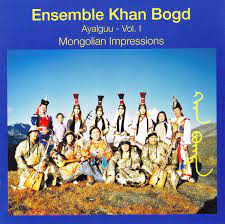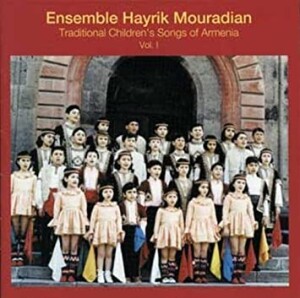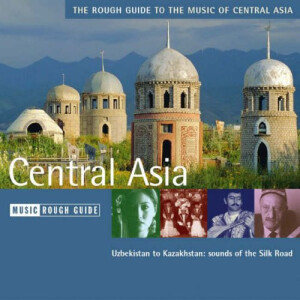 Many parts of Asia have only recently been opened to the West. Many of these lands have for much of the past several centuries been under the sway of huge empires – the Ottomans, Tsarist Russia, the Mongols, ancient and modern China, the Soviet Union. Since the fall of the Soviet Union and the beginnings of the opening of China, we’re seeing and hearing new sights and sounds from these lands. This collection of CDs dips a proverbial toe into those waters. (One of the volumes doesn’t properly belong, being set in the southern Asian lands of the Armenians, but this music was heavily influenced by the Ottomans, and is put out by the same label as three of the others, so is included here.)
Many parts of Asia have only recently been opened to the West. Many of these lands have for much of the past several centuries been under the sway of huge empires – the Ottomans, Tsarist Russia, the Mongols, ancient and modern China, the Soviet Union. Since the fall of the Soviet Union and the beginnings of the opening of China, we’re seeing and hearing new sights and sounds from these lands. This collection of CDs dips a proverbial toe into those waters. (One of the volumes doesn’t properly belong, being set in the southern Asian lands of the Armenians, but this music was heavily influenced by the Ottomans, and is put out by the same label as three of the others, so is included here.)
These are all splendid recordings in their own way, each with its individual charms. My favorite is Volume I from Ensemble Üch-Süme-R, three young people from the Altai Republic where the former USSR borders China, Mongolia and Kazakhstan. These three musicians perform traditional songs of Altai and Khakassia, the nearby Siberian steppe region, in addition to contemporary songs of their own composition. The group’s name means three peaks, and is a reference to the holy mountains of the Khakass, as well as a reference to the musical trio.
The two young men, Emil Terkish and Erturk Jety-Sary, use four different overtone or throat-singing styles, mostly the mid-range khai but also in the high sygyt and very low karkiraa, as well as the koomoi style which produces both very high and very low overtones. They also sing in “normal” voices, as does the young woman Toma Tchousheyeva. They accompany themselves on a several traditional instruments: rattles and frame drums, a topshur or two-stringed lute; ikili or two-stringed fiddle; an end-blown flute called a shoor; a zither called chatkhan; and a type of jew’s harp called komus.
As might be expected from a region that has been influenced by so many Asian cultures, this music sometimes sounds Inuit, sometimes vaguely Kurdish or Armenian, sometimes Chinese or even Japanese, and of course very close to Tibetan or Tuvan because of the overtone singing.
It opens with a Siberian “Shaman dance,” with an introduction of soft frame drum beats and rattles, quickening into a rhythmic throat-singing duet that incorporates khai, sygyt and koomoi styles. It goes on for another 16 tracks of quite a bit of variety. There is “Chatkhan oiyny,” a chatkhan solo, the only instrumental. There is one unaccompanied song, a duet featuring Toma and Erturk on “Ulu chöl” a traditional Altai song about the great steppe, an impressive demonstration of vocal control and melody. There are short songs like “An’chy,” a traditional hunter’s dance on the jew’s harp and a fluttery flute, and “Irlik’s dance,” a demonic dance featuring drum, rattles and koomoi and khai singing, punctuated with lots of “ahhhhhhh” sighs. And there are longer works like “Topshuurym,” on the lute and jew’s harp, with khai vocals entreating the lute to sing stories of legendary warriors. In “Chir,” the chatkhan is plucked like a European harp as Toma and Erturk sing alternating verses and finally in unison.
I have two favorites. The first is “Argymak,” a song written by Emil about his favorite race horse, featuring the galloping sound of jews harp, rattle, and lute, and with Emil singing first in normal voice, then in khai. The second is the penultimate track, “Algystyg saryn,” a traditional Khakass song, a prayer for the motherland that is stark, simple and beautiful with just Emil singing in sygyt style and playing the lute and Erturk the jew’s harp.
The recording technique used is pristine, clear and sharp, beautifully presenting these musicians in a simple setting that gives the impression that they’re performing on a remote mountaintop. This is simply a lovely recording, and I hope to hear more from Ensemble Üch-Süme-R
 The Ensemble Khan Bogd is a Mongolian group of young men and women, directed by Gankhuyag Natsag. They sing a variety of styles, male and female vocals usually separate, and play traditional instruments. Chief among the instruments is the morin khuur, a horse-head violin with two strings, long neck and boxlike body that plays a range that’s equivalent to a violin and a cello. Others include a transverse flute, a type of oboe, a two-stringed lute, a Chinese-style snakeskin fiddle, a type of hammer dulcimer and a large zither.
The Ensemble Khan Bogd is a Mongolian group of young men and women, directed by Gankhuyag Natsag. They sing a variety of styles, male and female vocals usually separate, and play traditional instruments. Chief among the instruments is the morin khuur, a horse-head violin with two strings, long neck and boxlike body that plays a range that’s equivalent to a violin and a cello. Others include a transverse flute, a type of oboe, a two-stringed lute, a Chinese-style snakeskin fiddle, a type of hammer dulcimer and a large zither.
On Vol. I they perform two main types of songs: a long song, usually with a solo female vocalist and simple accompaniment, generally the morin khuur; and a short song, which features a full ensemble of instruments and sometimes mixed-sex vocals, more rhythmic and often with improvised vocals. The long songs are peaceful and stately, and feature impressive exhibitions of breath control, with highly melismatic vocals that swoop and soar through the pentatonic scale. The short songs occasionally feature alternating male-female vocals, and the male vocals on the short songs are usually in a throat-singing style.
The album is nicely sequenced, with a long song generally followed by two or three short ones, although the first 15 of the 21 tracks are sung by women. Two tracks, “Taliin Tavan Tolgoi” and “Jiijuu khantaaz,” are by solo unaccompanied female voice. The former song is a besreg song or lament about five mountain peaks; the latter a playful number in which a woman sings about her boyfriend’s embroidered jacket. A particularly stirring song is “Dörvön tsagiin tal” or the four seasons in the steppe, with the full ensemble playing and male and female vocals alternating, and singing together in the final verse. The final track is a two-song suite, the second one called “horseman,” with a galloping rhythm on the zither and high overtone singing called höömij.
 Judging by the cover photo, Vol. II is played by a smaller ensemble. It is devoted as well to two types of songs, the magtaal or praise song, and demonstrations of various styles of höömij throat singing. The praise songs include one dedicated to the man known in the West as Genghis Khan, here spelled Chingiss Khaan. Some of these songs are long, up to nine minutes as on track 3, a song in praise for the tribe of the Oird – this one is a whole suite of mini-songs in different tempos and many styles of throat singing.
Judging by the cover photo, Vol. II is played by a smaller ensemble. It is devoted as well to two types of songs, the magtaal or praise song, and demonstrations of various styles of höömij throat singing. The praise songs include one dedicated to the man known in the West as Genghis Khan, here spelled Chingiss Khaan. Some of these songs are long, up to nine minutes as on track 3, a song in praise for the tribe of the Oird – this one is a whole suite of mini-songs in different tempos and many styles of throat singing.
The rhythms and melodies on this disc sound as though they’re influenced by other forms from around the world, but I’m pretty sure they’re not. Nevertheless, one of the sections of the Oird praise song sounds Scandinavian, another dedicated to a mountain named Jargalant sounds like a one-chord blues with a near-rock beat, and yet another, “Setgemj” or four mountains, sounds for all the world like Mongolian doo-wop! Another song from western Mongolia has both male and female voices and is in three-four time. The final track is 11 minutes long in many sections, including spoken prayers, lots of shamanic rattles and drums, the full instrumental ensemble and many voices, in praise of their homeland, spiritual and temporal rulers and artists of the past, and Buddhism.
As with all of these recordings from Face Music, the liner notes are quite good, including translations of the songs and an explanation of the instruments, vocal styles and the country’s history and geography. Quite impressive. And again, considering the youth of the musicians, musically impressive as well.
 Hayrik Mouradian was a historian and musician who helped assure the survival of Armenian folk songs. A survivor of the Armenian genocide of the early 20th Century, he collected traditional songs and helped make sure that people kept singing them, particularly children.
Hayrik Mouradian was a historian and musician who helped assure the survival of Armenian folk songs. A survivor of the Armenian genocide of the early 20th Century, he collected traditional songs and helped make sure that people kept singing them, particularly children.
This disc collects 37 of them, all performed by a small ensemble of children and adolescents, several of them the children of Hasmik Harutyunan, who was one of Mouradian’s students. The songs include work songs, ceremonial songs, dances, lullabies and other play songs. Some are a capella, some accompanied by traditional Armenian instruments – the duduk, a type of oboe, flutes, the kanun zither and simple frame drums. The performances are lively and the harmonies lovely.
As with other Face releases, this one packs a lot of information into the CD booklet. Its tone, however, is fairly pedantic for the most part, which definitely does not reflect the music’s presentation. And the notes about the individual songs are quite good, but they’re not set down in order. I’m not quite sure why the notes for tracks 1, 37 and 6 appear in that order, for instance, but they do. It makes following along problematic.
An entire disc of children’s voices is a bit too much of a good thing for me, but I realize that doesn’t apply to everyone. If you love good children’s singing, no matter the language or idiom, this disc would probably appeal to you.
 The Rough Guide to the Music of Central Asia is an outstanding example of what the Rough Guides do best: focus on the roots-related music of a specific region, and illustrate through judicious selection and juxtaposition the way musicians in that region are melding traditional and modern influences. In this case, the region is the “Stans” of the former Soviet Union: Kazakhstan, Kyrgyzstan, Tajikstan, Uzbekistan and Turkmenistan. The selections here range from the utterly traditional to the thoroughly modern.
The Rough Guide to the Music of Central Asia is an outstanding example of what the Rough Guides do best: focus on the roots-related music of a specific region, and illustrate through judicious selection and juxtaposition the way musicians in that region are melding traditional and modern influences. In this case, the region is the “Stans” of the former Soviet Union: Kazakhstan, Kyrgyzstan, Tajikstan, Uzbekistan and Turkmenistan. The selections here range from the utterly traditional to the thoroughly modern.
In the former camp, the best examples include Yagmyr Nurgeldyev (Turkmenistan) with a solo piece on the two-stringed dutar; an instrumental tour-de-force by Abdorahman Nurak, who could be called the Kyrgyz Richard Thompson for the way he stretches the possibility of the three-stringed komuz lute; and a masterful piece featuring the wooden jew’s harp by the Kambarkan Folk Ensemble of Kyrgyzstan.
The absolute best of the modern cuts is the album’s opening track, “Adai,” an instrumental workout by the Kazakh folk-rockers Ulytau, who sound as though they’ve been listening to early Fairport Convention (and maybe some Mahavishnu Orchestra) – hot fiddle and rock drums, with electric guitars the traditional long-necked dombra lute. Uzbek pop singer Sevara Nazarkhan sings a contemporary version of a traditional song, backed by her band and featuring the bowed sato lute. I’m no judge of rap, American or any other kind, so I can’t really judge the Tajik rap (in English) of Nobovar & Shams Group, although I do enjoy the non-rapped portions of their track, based on a Pamir folk tune. Some hot fiddling here too, plus electric guitar and frantic percussion. The Kazakh musician Edil Husainov ends this collection with a fascinating tour through central Asian styles and instruments, beginning with the jew’s harp, taking a stop in Mongolian-style overtone singing, the okarina, flute and zither, with keyboards, drums, bass and electric guitar added to the mix – a bit of shamanistic dance-hall. The Tajik duo Farzin do something similar with a traditional folk tune, putting a modern beat behind it, and featuring accordion in addition to electric bass and guitar.
Readers of Songlines, the English world music magazine, will no doubt recognize the voice behind the liner notes as that of Simon Broughton, who also oversaw the selections on this compilation. And a fine job he and all involved did.
Ensemble Üch-Süme-R, Traditional songs of the Khakass and the Altai people (Face Music, 2002)
Ensemble Khan Bogd, Mongolian Impressions, Vol. I (Face Music, 2005)
Ensemble Khan Bogd, Magtaal-Höömij, Vol. II (Face Music, 2005)
Ensemble Hayrik Mouradian, Traditional Children’s Songs of Armenia, Vol. I (Face Music, 2005)
Various artists, The Rough Guide to the Music of Central Asia (World Music Network, 2005)
